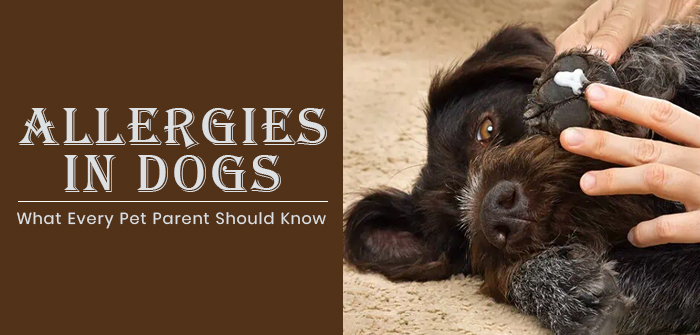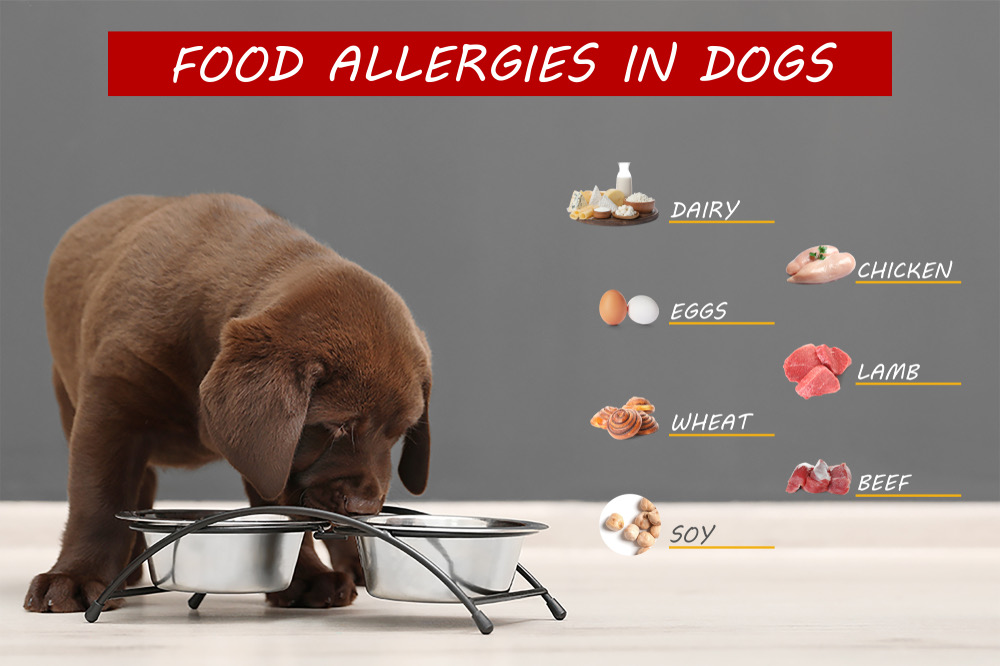Introduction
Introduction:
Canine allergies are a common and often misunderstood issue among dog owners. These allergies can cause a range of discomfort for dogs, from mild itching to more severe symptoms like inflammation and respiratory distress. As a responsible dog owner, it's essential to be informed about canine allergies and know how to best manage them.
Understanding the different types of allergies and their signs and symptoms is the first step in providing effective care for your furry friend. Food allergies, for example, can manifest in digestive issues or skin problems, while environmental allergies may cause sneezing, itching, or paw licking.
Diagnosing canine allergies can be challenging, but with the right approach, it is possible to identify the triggers. Allergy testing and elimination diets are common methods used by veterinarians to pinpoint the allergens causing your dog's reactions.
Once your dog's allergies are diagnosed, you can implement various treatment options, including medications and immunotherapy. Avoiding allergens also plays a crucial role in managing your dog's allergies and creating an allergy-friendly environment at home. Additionally, understanding the seasonal triggers and secondary infections associated with allergies is vital for your dog's overall well-being.
In this article, we will explore the different aspects of canine allergies, including their types, diagnosis, treatment, and prevention. By gaining a comprehensive understanding of your dog's allergies, you can provide the best possible care for your furry companion.
Understanding Canine Allergies

Canine allergies are a common health issue that many dog owners encounter. Understanding these allergies is crucial in providing proper care and treatment for our furry friends.
Canine allergies occur when a dog's immune system overreacts to certain substances known as allergens. These allergens can vary from food ingredients to environmental factors such as pollen, dust mites, or mold. When a dog comes into contact with these allergens, their immune system releases histamines, leading to a range of symptoms.
Symptoms of canine allergies can manifest in various ways, including itching, paw chewing, ear infections, skin redness or hot spots, and gastrointestinal issues like vomiting or diarrhea. It is essential to note that these symptoms can be similar to other health conditions, so proper diagnosis is crucial.
Understanding the different types of canine allergies, such as food and environmental allergies, can help identify and manage them effectively. By understanding the triggers and symptoms, dog owners can implement appropriate treatments, such as eliminating specific ingredients from their dog's diet or creating an allergy-friendly environment. Veterinary assistance should be sought for accurate diagnosis and precise treatment plans.
Common Signs and Symptoms of Canine Allergies
Common Signs and Symptoms of Canine Allergies
When it comes to canine allergies, it's important to be able to recognize the signs and symptoms in order to provide prompt care for your furry friend. While symptoms may vary from dog to dog, there are some common signs that can indicate an allergic reaction.
One telltale sign of canine allergies is excessive itching and scratching. If you notice your dog constantly scratching, biting, or licking themselves, it could be a sign of allergies. Other symptoms may include red and inflamed skin, rashes, hair loss, ear infections, and frequent sneezing or coughing.
Allergies can also affect a dog's digestive system, leading to symptoms such as vomiting, diarrhea, or changes in appetite. Additionally, some dogs may experience respiratory symptoms like wheezing or difficulty breathing.
It's important to note that these symptoms can also be related to other health conditions, so it's crucial to consult with a veterinarian for a proper diagnosis. Once the cause of the allergies is determined, appropriate treatment can be recommended to help alleviate your dog's discomfort and improve their overall well-being.
Types of Canine Allergies

Canine allergies can manifest in various forms, with the two most common types being food allergies and environmental allergies.
Food allergies occur when a dog's immune system reacts negatively to certain ingredients in their diet. Common food allergens include proteins found in beef, dairy, chicken, wheat, and soy. Dogs with food allergies may experience symptoms such as itching, digestive issues, and skin irritations.
On the other hand, environmental allergies are triggered by substances in the surrounding environment, such as pollen, dust mites, mold, and certain chemicals. These allergens can be inhaled or come into contact with a dog's skin, leading to allergic reactions. Symptoms of environmental allergies may include sneezing, watery eyes, itching, and skin rashes.
It is important for dog owners to be aware of these different types of allergies as they require different approaches for management and treatment. Identifying and managing food allergies may involve conducting elimination trials to pinpoint the allergenic ingredients, while environmental allergies might require efforts to minimize exposure to the offending allergens and the use of medications to alleviate symptoms. Consultation with a veterinarian is crucial to accurately diagnose the specific allergy and develop an effective treatment plan for your furry friend.
Food Allergies: Identifying and Managing

Food allergies in dogs can cause a range of symptoms, including itchy skin, gastrointestinal upset, and even chronic ear infections. Identifying and managing food allergies is essential for the well-being of your canine companion.
To identify the culprit, a food trial is often recommended. This involves feeding your dog a hypoallergenic diet consisting of novel protein sources (such as venison, duck, or rabbit) and carbohydrates that they have not been exposed to before. This elimination diet aims to determine if the symptoms diminish or disappear while your dog is on this special diet.
Once the allergen is identified, managing food allergies involves strict avoidance. This means eliminating any trace of the allergenic food from your dog's diet. It's important to carefully read ingredient labels and avoid any foods that contain the allergen. Your veterinarian may recommend specific hypoallergenic dog foods or help you create a balanced homemade diet suitable for your dog's nutritional needs.
Remember, it may take time to identify and manage your dog's food allergies, but with patience and proper guidance from your veterinarian, you can help your furry friend lead a healthy and happier life.
Environmental Allergies: Pollen, Dust Mites, and more

Environmental Allergies: Pollen, Dust Mites, and more
Environmental allergies are a common cause of canine allergies. Dogs, just like humans, can react to various environmental triggers such as pollen, dust mites, mold spores, and certain grasses or plants. These allergens are usually inhaled or come into contact with the dog's skin, leading to an allergic reaction.
Pollen is a common environmental allergen that can cause symptoms like sneezing, itching, and watery eyes in dogs. As the seasons change, different types of pollen become prevalent, leading to seasonal allergies in dogs.
Dust mites are tiny bugs that thrive in bedding, carpets, and upholstery. Dogs can develop allergies to the proteins found in dust mite feces. Symptoms of dust mite allergies in dogs include itching, redness, and hair loss.
To manage environmental allergies, it is crucial to minimize exposure to the allergens. Regular cleaning, using hypoallergenic bedding, and installing air purifiers can help reduce allergens in the dog's environment.
In severe cases, veterinarians may recommend allergy shots or immunotherapy to desensitize the dog's immune system to specific allergens. These treatments can provide long-term relief and reduce the severity of allergic reactions.
Understanding and addressing environmental allergies is vital for every dog owner. By identifying and managing these triggers, owners can help their furry companions live a more comfortable and allergy-free life.
Diagnosing Canine Allergies

When it comes to diagnosing allergies in dogs, there are a few different approaches that veterinary professionals may take. One common method is allergy testing, which can help identify the specific allergens that are causing a dog's symptoms. Allergy testing can be done through either blood tests or intradermal skin tests.
Blood tests, such as enzyme-linked immunosorbent assays (ELISAs) or allergen-specific IgE tests, can measure the levels of antibodies in the blood that are produced in response to allergens. These tests can provide valuable information about what specific substances a dog may be allergic to.
Intradermal skin tests involve injecting small amounts of allergens into a dog's skin and observing any reactions. This can help identify the specific allergens that are causing a dog's symptoms.
Another diagnostic tool is elimination diets and trial periods. By carefully removing potential allergens from a dog's diet or environment and then reintroducing them one by one, pet owners and veterinarians can pinpoint the specific allergen that is causing the dog's allergic reactions.
It's important to work closely with a veterinarian to determine the best diagnostic approach for your dog and to ensure accurate and effective diagnosis of canine allergies.
Allergy Testing for Dogs: Options and Process

There are several options available when it comes to allergy testing for dogs. The process typically involves identifying the specific allergens that are causing a dog's allergic reactions. This is important in order to develop an effective treatment plan for the dog.
One common method of allergy testing for dogs is intradermal skin testing. This involves injecting small amounts of allergens into the dog's skin and observing for any reactions. Another option is blood testing, which measures the presence of certain antibodies in the dog's bloodstream. This can help identify specific allergens that are causing allergic reactions.
It's important to note that allergy testing should be conducted by a veterinarian who specializes in allergy and dermatology. They have the knowledge and expertise to accurately interpret the results and develop an appropriate treatment plan.
The results of allergy testing can help guide treatment options, including the use of medications, immunotherapy, or dietary changes. Understanding the specific allergens that affect a dog can greatly improve their quality of life and overall well-being.
Elimination Diets and Trial Periods: Finding the Culprit

Elimination diets and trial periods are often used to identify the specific culprit causing a dog's allergies. The goal is to remove potential allergens from the dog's diet or environment and reintroduce them one at a time to observe any adverse reactions.
When it comes to food allergies, an elimination diet involves feeding the dog a novel protein source and a carbohydrate that they have never been exposed to before. This helps to rule out common allergens such as beef, chicken, or grains. Over a period of 8 to 12 weeks, the dog is fed only this limited ingredient diet while closely monitored for any signs of improvement.
If the dog's symptoms improve during the elimination diet, potential allergens can be reintroduced one at a time. This process, known as a trial period, involves adding back one ingredient at a time for a period of one to two weeks. If symptoms reappear, it can indicate an allergy to that specific ingredient.
In the case of environmental allergies, similar elimination techniques can be used. For example, if pollen is suspected, the dog may be kept indoors during high pollen seasons and gradually exposed to different types of pollen to identify the specific trigger.
Overall, elimination diets and trial periods can be helpful in pinpointing the cause of a dog's allergies, allowing owners to make informed decisions about managing their pet's condition. Consulting with a veterinarian is essential during this process to ensure the safety and well-being of the dog.
Treating Canine Allergies
Treating Canine Allergies:
When it comes to treating canine allergies, there are various options available to help alleviate your dog's discomfort. The specific treatment approach will depend on the type and severity of your dog's allergies, as well as the guidance of your veterinarian.
One common method of treating canine allergies is through the use of medications. Antihistamines, such as Benadryl, can help reduce itching and other allergy symptoms. Steroids may also be prescribed to help reduce inflammation and provide relief. These medications, however, should be used under veterinary supervision and with caution due to potential side effects.
Another treatment option for canine allergies is immunotherapy. This involves a series of allergy shots or oral drops that aim to desensitize your dog to specific allergens over time. Immunotherapy is often recommended for dogs with severe allergies or those that do not respond well to other treatments.
In addition to medication and immunotherapy, it's important to focus on avoiding allergens as much as possible. Creating an allergy-friendly environment for your dog, such as using hypoallergenic bedding and avoiding chemical-laden cleaning products, can help reduce exposure to common allergens. Regular bathing with a gentle, hypoallergenic shampoo can also help remove allergens from your dog's coat.
Managing canine allergies can be challenging, but with the right combination of treatments and environmental modifications, you can help your furry friend live a more comfortable and symptom-free life. Remember to consult with your veterinarian for a tailored treatment plan for your dog's specific needs.
Medications for Canine Allergies: Antihistamines, Steroids, and more
When it comes to treating canine allergies, medications can play a crucial role in managing your dog's symptoms. Two commonly used medications for canine allergies are antihistamines and steroids.
Antihistamines work by blocking the release of histamines, which are chemicals released by the immune system in response to an allergen. Histamines are responsible for the itching, redness, and swelling that often accompany allergies. Antihistamines can provide relief for mild to moderate allergy symptoms and are available in both over-the-counter and prescription forms.
Steroids, on the other hand, are powerful anti-inflammatory drugs that can effectively reduce inflammation and relieve severe allergy symptoms. However, long-term use of steroids should be carefully monitored by a veterinarian due to potential side effects.
In addition to antihistamines and steroids, there are other medications that may be prescribed to manage specific allergy symptoms in dogs. These may include immunosuppressants, allergy shots, or topical creams.
It's important to note that medication should always be used under the guidance of a veterinarian. They will be able to determine the most appropriate medications and dosage for your dog's specific allergies, taking into account their overall health and any underlying conditions.
Remember, while medications can provide relief, they are not a cure for canine allergies. Identifying the allergen and taking steps to avoid it will be the most effective long-term solution for managing your dog's allergies.
Immunotherapy for Dogs: Desensitizing Allergens

Immunotherapy, also known as allergy shots, is a long-term treatment option for dogs with severe allergies. It involves gradually exposing the dog to small amounts of the allergen that triggers their allergic reaction in order to desensitize their immune system. This process aims to reduce the dog's sensitivity to the allergen and minimize or eliminate their allergic symptoms over time.
During immunotherapy, a customized serum is created for the dog based on the results of allergen testing. The serum contains small amounts of the allergen, which are injected into the dog's body at regular intervals. The dose is increased gradually, allowing the dog's immune system to build tolerance to the allergen.
It's important to note that immunotherapy is a long-term commitment that requires consistent administration of the injections. While it may take several months to notice significant improvement, many dogs experience a reduction in symptoms and an improved quality of life.
Immunotherapy is typically recommended for dogs with allergies that do not respond well to other treatments or for those with severe and persistent symptoms. Consulting with a veterinarian is crucial to determine if your dog is a suitable candidate for immunotherapy and to establish a proper treatment plan.
Avoiding Allergens

To help manage canine allergies, it's important for dog owners to take steps to avoid potential allergens in their dog's environment. Here are some tips for avoiding allergens and creating an allergy-friendly environment for your furry friend:
- Cleanliness is key: Regularly clean your home to minimize allergens like dust mites and pet dander. Vacuum carpets, sweep floors, and dust surfaces to reduce allergen accumulation.
- Consider hypoallergenic bedding: Opt for hypoallergenic bedding materials to minimize exposure to allergens. Wash bedding frequently to remove any allergens that may have accumulated.
- Limit outdoor exposure: During high pollen seasons, try to limit your dog's time outdoors, particularly during peak pollen times of the day. Take walks in the early morning or late evening when pollen levels tend to be lower.
- Filter the air: Use high-quality air filters in your home to help capture airborne allergens. This can be particularly helpful for dogs with environmental allergies.
- Be mindful of household chemicals: Some cleaning products and air fresheners can irritate dogs with allergies. Use pet-friendly, non-toxic alternatives whenever possible.
By taking these precautions, you can create a more allergy-friendly environment for your dog and help minimize their exposure to allergens, providing them with a more comfortable and symptom-free life.
Creating a Allergy-Friendly Environment for Your Dog

Creating an allergy-friendly environment for your dog is crucial in managing their allergies and providing them with a comfortable living space. Here are some tips to create a safe and allergy-free environment for your furry friend.
First and foremost, keeping your home clean is essential. Regularly vacuuming and dusting will help reduce allergens such as pollen, dust mites, and pet dander. Consider using a vacuum cleaner with a HEPA filter to effectively remove allergens from carpets and upholstery.
Using hypoallergenic bedding for your dog can also make a significant difference. Opt for allergen-resistant materials for their bed, blankets, and toys to minimize the risk of triggering an allergic reaction.
Maintaining proper ventilation is essential to avoid the buildup of allergens. Opening windows to allow fresh air to circulate and using air purifiers with HEPA filters can help filter out allergens from the air.
If your dog has allergies to certain foods or environmental allergens, it may be necessary to modify their diet or limit their exposure to triggers. Consult with your veterinarian to develop a specialized diet plan that suits your dog's needs.
Additionally, bathing your dog regularly with hypoallergenic shampoos can help remove allergens from their fur and skin. However, be cautious not to over-bathe them, as it can strip their skin of natural oils and cause dryness.
By implementing these preventive measures, you can create an allergy-friendly environment that will provide your dog with much-needed relief from their allergy symptoms. Remember, always consult your veterinarian for proper guidance and treatment options tailored to your dog's specific needs.
Tips for Managing Canine Allergies at Home
Managing canine allergies at home can be a challenging task, but with the right strategies, dog owners can significantly alleviate their pet's discomfort. Here are some practical tips to help manage canine allergies within the home environment.
- Regular Cleaning: Keep your home clean and free from dust, pollen, and other allergens by vacuuming regularly and using air purifiers to filter the air.
- Allergy-Friendly Bedding: Use hypoallergenic bedding for your dog, such as washable or disposable pet beds, to reduce exposure to allergens.
- Bathing Routine: Establish a regular bathing routine using a gentle, hypoallergenic shampoo recommended by your veterinarian. This helps to remove allergens from your dog's coat.
- Diet Control: Consult with your veterinarian to identify and eliminate potential food allergens from your dog's diet. A hypoallergenic or limited ingredient diet may be recommended.
- Allergen-Free Zone: Create a designated allergen-free zone in your home, such as a specific room or area, where your dog can retreat to when allergens are particularly high.
- Paw Wiping: Clean your dog's paws after outdoor walks to prevent them from tracking allergens into your home.
- Regular Vet Check-ups: Schedule regular check-ups with your veterinarian to monitor your dog's allergies and adjust their treatment plan accordingly.
By implementing these tips, dog owners can help create a more comfortable and allergy-friendly environment for their allergic furry friends at home. Remember to consult with your veterinarian for personalized advice and guidance on managing your dog's specific allergies.
Dealing With Seasonal Allergies

Dealing With Seasonal Allergies:
When the seasons change, so do the allergens in the air, and this can pose a challenge for dogs with allergies. Spring and summer are notorious for triggering allergic reactions in dogs. The abundance of pollen from trees, weeds, and grasses can leave dogs scratching, sneezing, and experiencing itchy skin.
To help your furry friend cope with seasonal allergies, there are a few strategies you can employ. First, try to limit your dog's exposure to allergens by keeping them indoors during peak pollen times and avoiding areas with high levels of allergens. Regularly bathing your dog with hypoallergenic shampoos can also help remove allergens from their coat.
In addition to environmental measures, there are also medications available to alleviate the symptoms of seasonal allergies in dogs. Your veterinarian may recommend antihistamines or allergy shots to provide relief. These treatments can help reduce itchiness, sneezing, and overall discomfort.
However, it's important to note that seasonal allergies can vary in severity from dog to dog. If your dog's symptoms are severe or persistent, it's best to consult with your veterinarian. They can provide guidance on the most appropriate and effective treatment plan for your furry companion.
By taking proactive measures to manage your dog's seasonal allergies, you can help them enjoy the changing seasons without the discomfort of constant itching and sneezing.
Spring and Summer Allergies: Triggers and Solutions

During the spring and summer seasons, dogs can be susceptible to a variety of allergens that can trigger allergic reactions. One common trigger is pollen, which is released by trees, grasses, and plants during these seasons. Dogs can inhale or come into contact with pollen while outdoors, causing symptoms such as itching, sneezing, and watery eyes.
Another common trigger is dust mites, which thrive in warm and humid environments. These tiny insects can be found in bedding, carpets, and upholstery. When dogs come into contact with dust mites, they can experience allergic reactions, including itching, redness, and irritation.
To help alleviate spring and summer allergies in dogs, it is important to minimize their exposure to allergens. Keep dogs indoors during peak pollen times, such as early morning and evening. Regularly wash and vacuum their bedding to reduce dust mite populations. Additionally, consider using air purifiers or allergy-friendly filters in the home to remove allergens from the air.
If environmental controls are not enough to manage the allergies, veterinarians may recommend antihistamines or other medications to help alleviate symptoms. Always consult with a veterinarian before administering any medication to your dog.
By understanding the triggers and implementing appropriate solutions, dog owners can help their furry friends navigate the challenges of spring and summer allergies.
Fall and Winter Allergies: Preparing Your Dog

As the seasons change and the weather gets colder, it's important to be aware of the potential allergies that can affect your furry friend. Fall and winter allergies can bring about a whole new set of challenges for your dog, but with the right preparation, you can help minimize their discomfort.
One of the most common fall and winter allergens for dogs is mold. The damp and cool weather creates the perfect environment for mold spores to thrive. To prepare your dog for this allergen, be sure to keep them away from areas with excessive moisture, such as damp basements or piles of wet leaves. Regularly cleaning and vacuuming your home can also help reduce mold spores indoors.
Another common allergen during the colder months is dust mites. These microscopic creatures can trigger allergic reactions in dogs, leading to symptoms like sneezing and itching. To minimize your dog's exposure to dust mites, wash their bedding regularly in hot water and consider using hypoallergenic covers on their mattresses and pillows.
Additionally, indoor heating can dry out the air, leading to dry skin and itchiness in dogs. To combat this, you can use a humidifier to add moisture back into the air and keep your dog's skin hydrated.
By taking these precautions and being mindful of potential fall and winter allergens, you can help prepare your dog for the change in seasons and ensure their comfort throughout the year.
Secondary Infections and Complications

Secondary Infections and Complications:
When a dog suffers from allergies, their skin becomes more susceptible to secondary infections and complications. Constant scratching, licking, and chewing can break the skin barrier, allowing bacteria, yeast, or other pathogens to invade. This can result in skin infections, such as pyoderma, which are characterized by redness, swelling, and pustules.
Hot spots, also known as acute moist dermatitis, can also occur as a result of allergies. These are localized areas of inflamed and infected skin that are intensely itchy for the dog. If left untreated, hot spots can quickly become painful and lead to further complications.
In addition, dogs with allergies are prone to ear infections. Allergic reactions can cause inflammation in the ear canal, making it an ideal environment for bacterial or yeast overgrowth. Symptoms of ear infections include scratching at the ears, head shaking, foul odor, and discharge.
To prevent secondary infections, it is important to manage and treat the underlying allergies. Regular grooming, including cleaning ears and keeping the skin clean and dry, can help reduce the risk of infections. If your dog develops any signs of secondary infections, it is essential to seek veterinary assistance promptly to prevent further complications.
Skin Infections in Dogs with Allergies

Skin infections are a common complication in dogs with allergies. When a dog has allergies, they tend to itch and scratch excessively, leading to breaks in the skin. These breaks create openings for bacteria and fungi to enter, causing infections.
One common skin infection seen in dogs with allergies is called pyoderma, which is characterized by red, inflamed, and pus-filled lesions on the skin. Another type of infection that can occur is a yeast infection, which often leads to itchy, greasy, and smelly skin.
To treat these skin infections, it is important to address the underlying allergies that are causing the itching and scratching. Veterinary assistance may be required to determine the appropriate treatment plan, which may include antibiotics or antifungal medications to clear the infection. Additionally, antihistamines or steroids may be prescribed to help alleviate the allergy symptoms and reduce the itching.
Preventing skin infections in dogs with allergies involves managing the allergy itself. This may include avoiding known allergens, keeping the dog's environment clean, and regularly bathing the dog with hypoallergenic shampoos. In severe cases, a specialized diet or immunotherapy may be recommended to manage the underlying allergies.
By addressing and managing these skin infections, dog owners can help improve their canine companions' quality of life and prevent further complications from occurring. Regular check-ups with a veterinarian can ensure proper treatment and monitoring of the dog's allergies and skin health.
Hot Spots and Ear Infections: Preventing and Treating

Hot spots and ear infections are common complications that can occur in dogs with allergies. Hot spots, also known as acute moist dermatitis, are areas of inflamed and infected skin that are often caused by excessive scratching or licking. These hot spots can be painful for dogs and can worsen if left untreated.
To prevent hot spots, it’s important to address the underlying cause of the allergy. This may involve identifying and avoiding allergens, such as certain foods or environmental triggers. Regular grooming and keeping your dog's skin clean and dry can also help prevent hot spots from developing.
If your dog does develop a hot spot, it's important to intervene quickly to prevent it from spreading and becoming more severe. Treatment usually involves cleaning the affected area, trimming the hair around the hot spot, and applying a topical medication recommended by your veterinarian. In some cases, your veterinarian may also prescribe oral antibiotics to help clear the infection.
Ear infections are another common complication of canine allergies. Allergies can cause inflammation in the ear canals, leading to increased moisture and a breeding ground for bacteria and yeast. To prevent ear infections, regular ear cleaning and drying is essential. Your veterinarian may also recommend a topical ear medication to help prevent and treat ear infections caused by allergies.
By taking steps to prevent and treat hot spots and ear infections, you can help keep your dog comfortable and minimize the discomfort caused by allergic reactions. It's always important to consult with your veterinarian for proper diagnosis and treatment options for your dog's specific allergies.
Allergies or Something Else?

Distinguishing Canine Allergies from Other Dermatological Conditions
It's important for dog owners to be able to differentiate between allergies and other dermatological conditions that can affect their beloved pets. While allergies often present with symptoms such as itching, redness, and skin irritation, there are other conditions that can cause similar signs.
One common condition that can be mistaken for allergies is mange, which is caused by mites infesting the dog's skin. Mange can lead to intense itching and hair loss, similar to allergic reactions. Another condition to consider is ringworm, a fungal infection that can cause circular patches of hair loss. This can easily be mistaken for allergy-related hair loss.
If you notice your dog experiencing symptoms that resemble allergies, it's crucial to consult with a veterinarian for an accurate diagnosis. They will be able to perform tests, such as skin scrapings or fungal cultures, to determine the underlying cause of your dog's symptoms.
When to Seek Veterinary Assistance
If your dog is exhibiting signs of allergies or any other dermatological condition, it's important to seek veterinary assistance. Your vet can provide a proper diagnosis and recommend an appropriate treatment plan to alleviate your dog's discomfort. Remember, the sooner you address the issue, the better your dog's quality of life will be.
In conclusion, understanding the difference between allergies and other dermatological conditions is essential for dog owners. By being observant of your dog's symptoms and seeking veterinary assistance when needed, you can ensure your furry friend receives the proper care and treatment they deserve.
Distinguishing Canine Allergies from Other Dermatological Conditions

Canine allergies can often mimic other dermatological conditions, making it important for dog owners to be able to distinguish between the two. Some common dermatological conditions that can produce similar symptoms to allergies include skin infections, parasites, and autoimmune diseases.
Skin infections, such as bacterial or fungal infections, can cause redness, itching, and hair loss in dogs. These infections are usually localized and may have a distinct odor. Parasites like fleas, ticks, and mites can also cause intense itching and skin irritations. In these cases, inspecting the dog's fur and skin for the presence of these parasites can help with the diagnosis.
Autoimmune diseases like pemphigus or lupus can result in skin lesions, sores, and scabbing. These conditions typically affect multiple areas of the dog's body and can be accompanied by other systemic symptoms.
To determine whether a dog's symptoms are due to allergies or another dermatological condition, it is best to consult with a veterinarian who can conduct a thorough examination and may recommend additional testing, such as skin biopsies or blood tests.
Remember, accurate diagnosis is crucial in order to provide the appropriate treatment and relief for your furry friend's discomfort.
When to Seek Veterinary Assistance

If your dog is experiencing symptoms of allergies, it's important to know when it's time to seek veterinary assistance. While mild allergies can often be managed at home, there are situations where professional help is necessary.
If your dog's allergies are causing significant discomfort or interfering with their daily activities, it's time to consult a veterinarian. This includes persistent itching, excessive scratching or licking, and recurring skin infections. Additionally, if your dog experiences difficulty breathing, severe swelling, or any signs of an allergic reaction such as vomiting or diarrhea, immediate veterinary care is crucial.
A veterinarian can perform diagnostic tests to determine the specific allergen causing your dog's symptoms. They may recommend specialized allergy testing or suggest an elimination diet to identify the trigger. They can also provide guidance on treatment options and offer medications or immunotherapy if needed.
Remember, your veterinarian is your partner in managing your dog's allergies. They have the expertise and resources to help alleviate your dog's discomfort and improve their quality of life. Don't hesitate to reach out for professional assistance when necessary.
Conclusion

Caring for a dog with allergies can be challenging, but with the right knowledge and resources, it is possible to provide them with a comfortable and happy life. Understanding the different types of allergies and their signs and symptoms is crucial in identifying the triggers and implementing appropriate management strategies.
Diagnosing canine allergies often involves allergy testing and elimination diets, allowing pet owners to pinpoint the specific allergens affecting their dogs. Once identified, treatment options such as medications and immunotherapy can help alleviate symptoms and reduce the body's sensitivity to allergens.
Creating an allergy-friendly environment for your dog at home and being proactive in managing seasonal allergies can greatly improve the quality of life for your furry friend. It is also important to keep an eye out for secondary infections and complications that can arise from allergies, such as skin infections and hot spots.
If you suspect your dog has allergies, it is best to consult with a veterinarian who can provide guidance and support. With proper care and attention, you can help your allergic dog live a happy, healthy, and symptom-free life.
Caring for Your Allergic Dog: Tips and Best Practices

When it comes to caring for a dog with allergies, there are several important tips and best practices to keep in mind. First and foremost, it's crucial to work closely with your veterinarian to develop a comprehensive management plan for your furry friend. This may include identifying and avoiding allergens, implementing a special diet if necessary, and following a prescribed treatment regimen.
Creating an allergy-friendly environment is also essential. Regularly cleaning your home and washing your dog's bedding can help minimize exposure to allergens. Additionally, consider using air purifiers and HEPA filters to reduce airborne allergens.
Maintaining good grooming habits is another crucial aspect of caring for an allergic dog. Frequent bathing with a hypoallergenic shampoo can help soothe irritated skin and remove allergens from their coat.
Lastly, staying vigilant for any changes or worsening of symptoms is important. Keep a close eye on your allergic dog's condition and schedule regular check-ups with your veterinarian for ongoing monitoring and adjustments to their treatment plan if necessary.
By following these tips and best practices, you can provide the best care possible for your allergic dog and help them lead a comfortable and happy life.
Resources for Canine Allergy Management

When it comes to managing canine allergies, there are several resources available to help dog owners navigate the sometimes challenging process.
- Veterinary Clinics: Your first resource should always be your veterinarian. They are trained to diagnose and treat allergies in dogs and can provide valuable guidance and treatment options specific to your dog's needs. They may also be able to refer you to a veterinary dermatologist for further specialized care.
- Allergen-Specific Diets: Many pet food companies offer hypoallergenic diets formulated to eliminate common allergens. These diets can help identify and manage food allergies in dogs. Your veterinarian can recommend specific brands or varieties that may be suitable for your dog.
- Support Groups: Joining online forums or local support groups can connect you with other dog owners who are going through similar experiences. These communities can provide emotional support, helpful tips, and recommendations for managing allergies in dogs.
- Allergy Testing Laboratories: If your veterinarian suspects environmental allergies, they may recommend allergy testing. Various laboratory facilities offer testing services that can identify specific allergens causing a reaction in your dog. This information can help in developing a targeted treatment plan.
- Educational Websites and Publications: Many reputable websites and publications provide comprehensive information on canine allergies, treatment options, and management techniques. These resources can educate dog owners about allergies and guide them in making informed decisions regarding their dog’s health.
Remember, every dog is unique, and what works for one may not work for another. Consulting with a veterinarian and utilizing these resources can help you find the best approach to managing your dog's allergies and providing them with the relief they need.




0 Comments